Taxation Law
VerifiedAdded on 2023/01/11
|9
|2062
|29
AI Summary
This document provides an analysis of the tax consequences of employment-related receipts and allowable deductions for expenses incurred in obtaining taxable income. It discusses the rules and applications of income from personal exertion, sign-on fees, remuneration, superannuation benefits, and more. The case study concludes with the calculation of taxable income and allowable deductions. Subject: Taxation Law, Course code: N/A, Course name: N/A, College/University: N/A
Contribute Materials
Your contribution can guide someone’s learning journey. Share your
documents today.
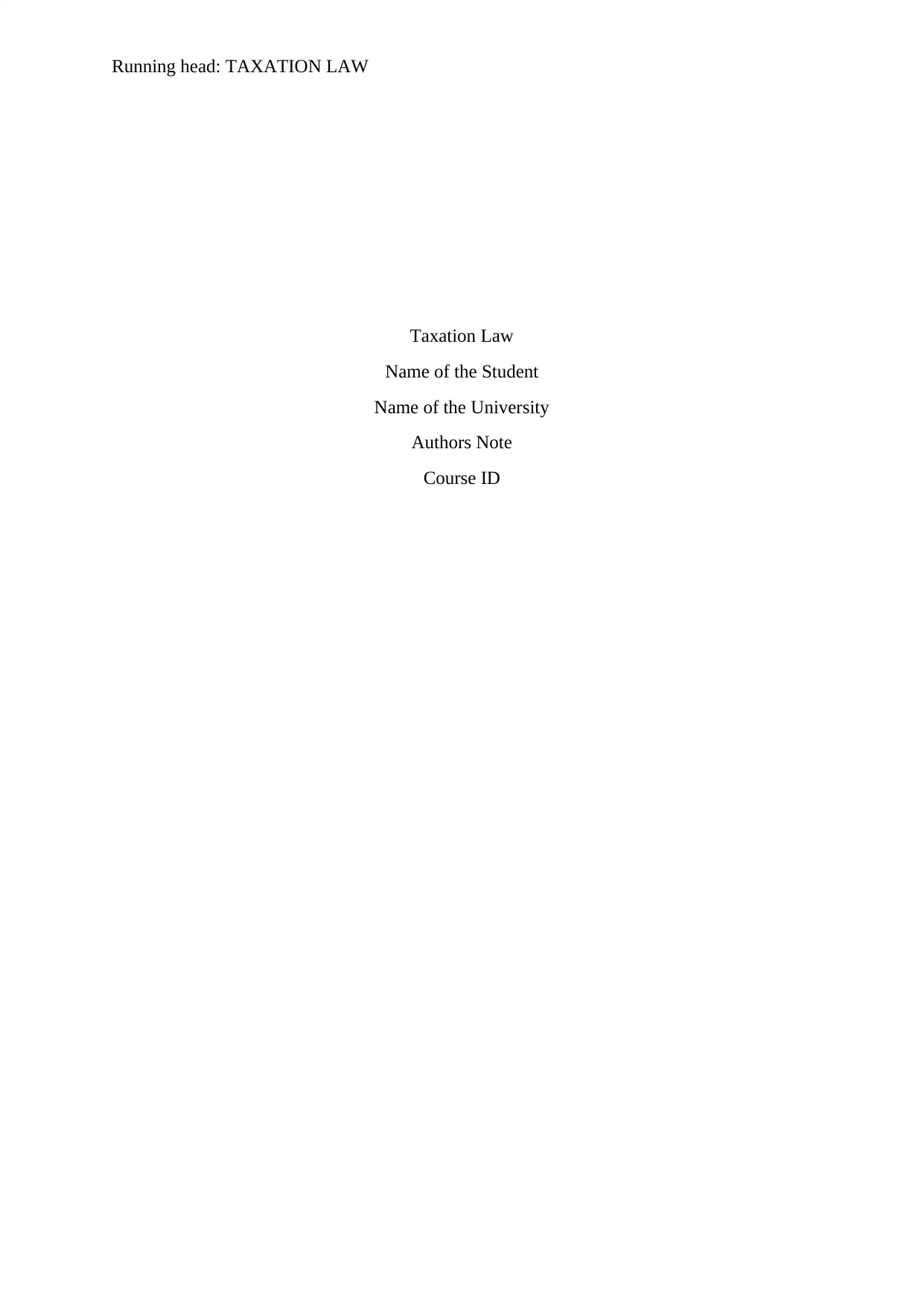
Running head: TAXATION LAW
Taxation Law
Name of the Student
Name of the University
Authors Note
Course ID
Taxation Law
Name of the Student
Name of the University
Authors Note
Course ID
Secure Best Marks with AI Grader
Need help grading? Try our AI Grader for instant feedback on your assignments.

1TAXATION LAW
Table of Contents
Answer to question 1:.................................................................................................................2
Issues:.........................................................................................................................................2
Rule:...........................................................................................................................................2
Application:................................................................................................................................4
Conclusion:................................................................................................................................6
References:.................................................................................................................................7
Table of Contents
Answer to question 1:.................................................................................................................2
Issues:.........................................................................................................................................2
Rule:...........................................................................................................................................2
Application:................................................................................................................................4
Conclusion:................................................................................................................................6
References:.................................................................................................................................7

2TAXATION LAW
Answer to question 1:
Issues:
The report will take into the account the tax consequences of the several employment
related receipts that are reported by the taxpayer in discharge of the employment. The issue
involves whether the taxpayer will be able to obtain allowable deduction for expenses that are
occurred in obtaining taxable income.
Rule:
As defined in “section 6, ITAA 1936”, income that are obtained from the personal
exertion generally comprises of the salaries, wages, bonuses etc. that are held assessable for
the recipient (Woellner et al. 2016). Provided that the receipts has adequate relation with the
income earning capacities of the taxpayer then it is held as the assessable receipts within
ordinary concepts of “section 6-5, ITAA 1997”. A large part of the income that is received by
the taxpayer is held as the ordinary income. The judgement in “Scott v CT (1935)” held that
income should not be viewed as a expression of art and there is an application of appropriate
principles to consider the receipts in accordance with the ordinary concepts (Braithwaite and
Reinhart 2019).
There are situations where the employers attract the candidates for employment
purpose by offering with the sign-on-fees. As stated by court in “FCT v Pickford (1998)” the
receipt of sign on fees by the fellow employee upon the joining of a new job was treated as
the payment for the future services and was income in accordance with the ordinary concept
of “section 6-5, ITAA 1997” (Barkoczy 2016).
Where a taxpayer obtains income from the personal services are regarded as the
employment payment and are treated assessable in the recipients hand. Similarly, in “Dean
Answer to question 1:
Issues:
The report will take into the account the tax consequences of the several employment
related receipts that are reported by the taxpayer in discharge of the employment. The issue
involves whether the taxpayer will be able to obtain allowable deduction for expenses that are
occurred in obtaining taxable income.
Rule:
As defined in “section 6, ITAA 1936”, income that are obtained from the personal
exertion generally comprises of the salaries, wages, bonuses etc. that are held assessable for
the recipient (Woellner et al. 2016). Provided that the receipts has adequate relation with the
income earning capacities of the taxpayer then it is held as the assessable receipts within
ordinary concepts of “section 6-5, ITAA 1997”. A large part of the income that is received by
the taxpayer is held as the ordinary income. The judgement in “Scott v CT (1935)” held that
income should not be viewed as a expression of art and there is an application of appropriate
principles to consider the receipts in accordance with the ordinary concepts (Braithwaite and
Reinhart 2019).
There are situations where the employers attract the candidates for employment
purpose by offering with the sign-on-fees. As stated by court in “FCT v Pickford (1998)” the
receipt of sign on fees by the fellow employee upon the joining of a new job was treated as
the payment for the future services and was income in accordance with the ordinary concept
of “section 6-5, ITAA 1997” (Barkoczy 2016).
Where a taxpayer obtains income from the personal services are regarded as the
employment payment and are treated assessable in the recipients hand. Similarly, in “Dean
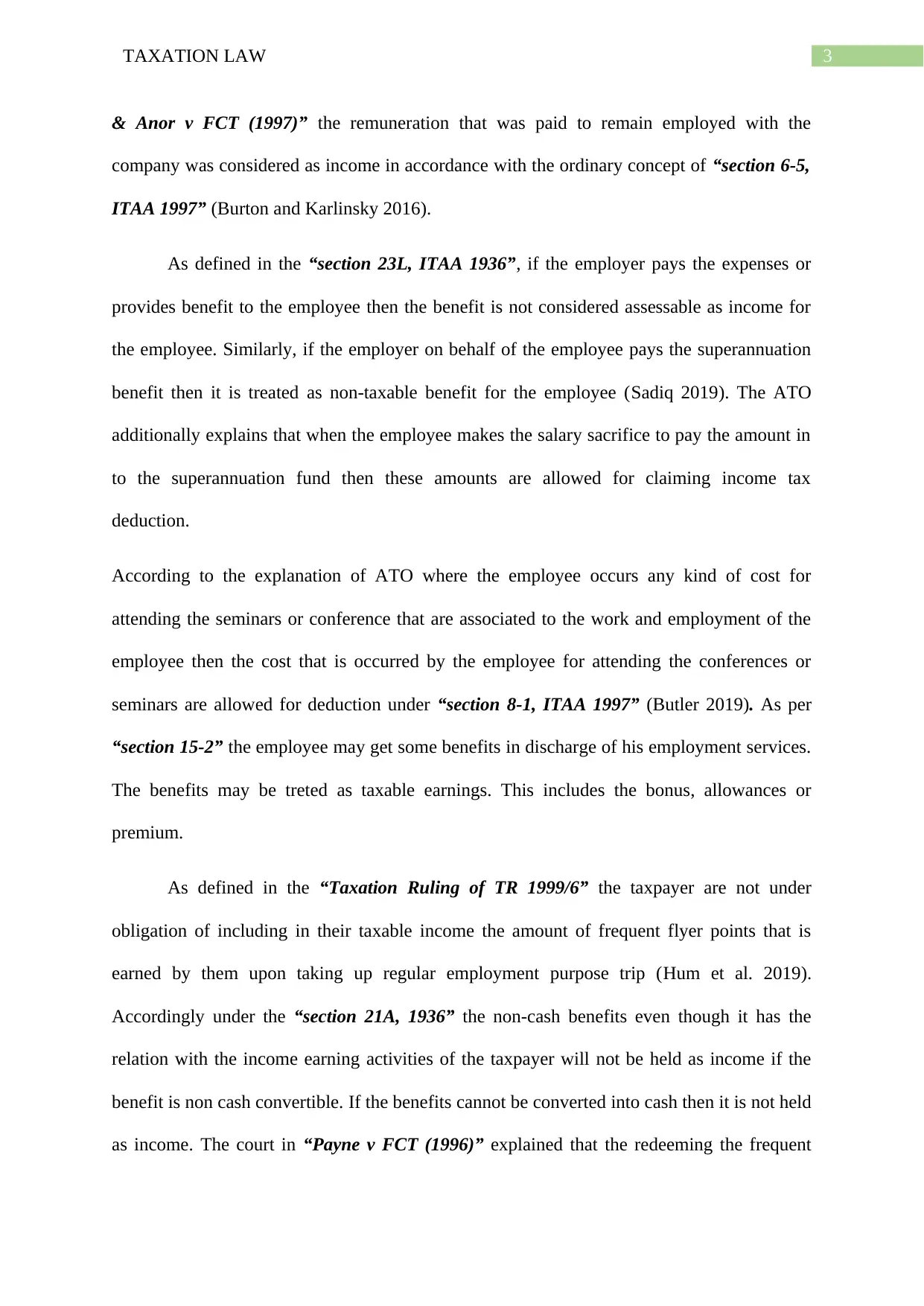
3TAXATION LAW
& Anor v FCT (1997)” the remuneration that was paid to remain employed with the
company was considered as income in accordance with the ordinary concept of “section 6-5,
ITAA 1997” (Burton and Karlinsky 2016).
As defined in the “section 23L, ITAA 1936”, if the employer pays the expenses or
provides benefit to the employee then the benefit is not considered assessable as income for
the employee. Similarly, if the employer on behalf of the employee pays the superannuation
benefit then it is treated as non-taxable benefit for the employee (Sadiq 2019). The ATO
additionally explains that when the employee makes the salary sacrifice to pay the amount in
to the superannuation fund then these amounts are allowed for claiming income tax
deduction.
According to the explanation of ATO where the employee occurs any kind of cost for
attending the seminars or conference that are associated to the work and employment of the
employee then the cost that is occurred by the employee for attending the conferences or
seminars are allowed for deduction under “section 8-1, ITAA 1997” (Butler 2019). As per
“section 15-2” the employee may get some benefits in discharge of his employment services.
The benefits may be treted as taxable earnings. This includes the bonus, allowances or
premium.
As defined in the “Taxation Ruling of TR 1999/6” the taxpayer are not under
obligation of including in their taxable income the amount of frequent flyer points that is
earned by them upon taking up regular employment purpose trip (Hum et al. 2019).
Accordingly under the “section 21A, 1936” the non-cash benefits even though it has the
relation with the income earning activities of the taxpayer will not be held as income if the
benefit is non cash convertible. If the benefits cannot be converted into cash then it is not held
as income. The court in “Payne v FCT (1996)” explained that the redeeming the frequent
& Anor v FCT (1997)” the remuneration that was paid to remain employed with the
company was considered as income in accordance with the ordinary concept of “section 6-5,
ITAA 1997” (Burton and Karlinsky 2016).
As defined in the “section 23L, ITAA 1936”, if the employer pays the expenses or
provides benefit to the employee then the benefit is not considered assessable as income for
the employee. Similarly, if the employer on behalf of the employee pays the superannuation
benefit then it is treated as non-taxable benefit for the employee (Sadiq 2019). The ATO
additionally explains that when the employee makes the salary sacrifice to pay the amount in
to the superannuation fund then these amounts are allowed for claiming income tax
deduction.
According to the explanation of ATO where the employee occurs any kind of cost for
attending the seminars or conference that are associated to the work and employment of the
employee then the cost that is occurred by the employee for attending the conferences or
seminars are allowed for deduction under “section 8-1, ITAA 1997” (Butler 2019). As per
“section 15-2” the employee may get some benefits in discharge of his employment services.
The benefits may be treted as taxable earnings. This includes the bonus, allowances or
premium.
As defined in the “Taxation Ruling of TR 1999/6” the taxpayer are not under
obligation of including in their taxable income the amount of frequent flyer points that is
earned by them upon taking up regular employment purpose trip (Hum et al. 2019).
Accordingly under the “section 21A, 1936” the non-cash benefits even though it has the
relation with the income earning activities of the taxpayer will not be held as income if the
benefit is non cash convertible. If the benefits cannot be converted into cash then it is not held
as income. The court in “Payne v FCT (1996)” explained that the redeeming the frequent
Secure Best Marks with AI Grader
Need help grading? Try our AI Grader for instant feedback on your assignments.

4TAXATION LAW
flyer points was not held as income because it is non-convertible to cash (Morgan, Mortimer
and Pinto 2018).
Compensation usually has the character of replacing something. If a person is
compensated for any kind of loss to the capital asset then the compensation amount is held as
capital receipts and non-taxable (Barrett 2018). Where a taxpayer receives compensation for
the lost earnings then it is not considered taxable for the recipients. Compensation received
for the work place injuries are not held as income under “section 6-5, ITAA 1997”.
Application:
Anna upon joining was given the sign on fees that amounted to a bonus of $5,000.
Citing the example of in “FCT v Pickford (1998)” the receipt of sign on fees by Anna upon
the joining of a new job was treated as the payment for the future services and was income in
accordance with the ordinary concept of “section 6-5, ITAA 1997” (Morgan and Castelyn
2018).
She was given remuneration from the employment and she was paid with the
additional amount of bonus that were subjected to the market conditions. With reference to
the court decision in “Dean & Anor v FCT (1997)” the employment salary and bonus is
considered as income in accordance with the ordinary concept of “section 6-5, ITAA 1997”.
However, the bonus of $15,000 will not be considered taxable in the current year because it is
received in the next income year of 2019 (Cavenagh et al. 2018).
In the later part it is noticed that the employer has paid the superannuation for Anna.
Referring to “section 23L, ITAA 1936”, the employer pays the expenses or provides benefit
to the Anna in the form of superannuation benefit. Therefore, the benefit is not considered
assessable as income for the Anna (Robin and Barkoczy 2019). Later Anna made a salary
flyer points was not held as income because it is non-convertible to cash (Morgan, Mortimer
and Pinto 2018).
Compensation usually has the character of replacing something. If a person is
compensated for any kind of loss to the capital asset then the compensation amount is held as
capital receipts and non-taxable (Barrett 2018). Where a taxpayer receives compensation for
the lost earnings then it is not considered taxable for the recipients. Compensation received
for the work place injuries are not held as income under “section 6-5, ITAA 1997”.
Application:
Anna upon joining was given the sign on fees that amounted to a bonus of $5,000.
Citing the example of in “FCT v Pickford (1998)” the receipt of sign on fees by Anna upon
the joining of a new job was treated as the payment for the future services and was income in
accordance with the ordinary concept of “section 6-5, ITAA 1997” (Morgan and Castelyn
2018).
She was given remuneration from the employment and she was paid with the
additional amount of bonus that were subjected to the market conditions. With reference to
the court decision in “Dean & Anor v FCT (1997)” the employment salary and bonus is
considered as income in accordance with the ordinary concept of “section 6-5, ITAA 1997”.
However, the bonus of $15,000 will not be considered taxable in the current year because it is
received in the next income year of 2019 (Cavenagh et al. 2018).
In the later part it is noticed that the employer has paid the superannuation for Anna.
Referring to “section 23L, ITAA 1936”, the employer pays the expenses or provides benefit
to the Anna in the form of superannuation benefit. Therefore, the benefit is not considered
assessable as income for the Anna (Robin and Barkoczy 2019). Later Anna made a salary
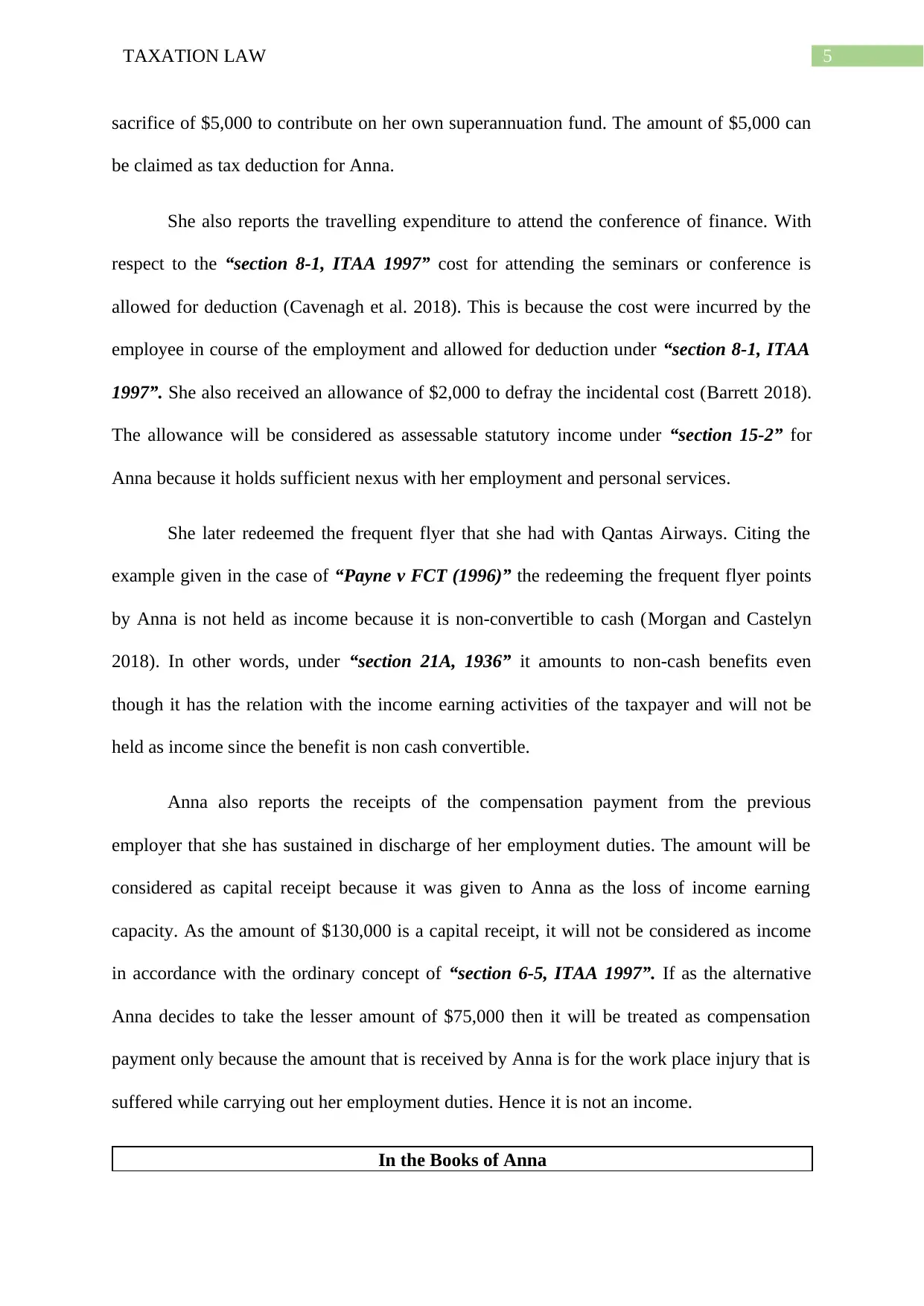
5TAXATION LAW
sacrifice of $5,000 to contribute on her own superannuation fund. The amount of $5,000 can
be claimed as tax deduction for Anna.
She also reports the travelling expenditure to attend the conference of finance. With
respect to the “section 8-1, ITAA 1997” cost for attending the seminars or conference is
allowed for deduction (Cavenagh et al. 2018). This is because the cost were incurred by the
employee in course of the employment and allowed for deduction under “section 8-1, ITAA
1997”. She also received an allowance of $2,000 to defray the incidental cost (Barrett 2018).
The allowance will be considered as assessable statutory income under “section 15-2” for
Anna because it holds sufficient nexus with her employment and personal services.
She later redeemed the frequent flyer that she had with Qantas Airways. Citing the
example given in the case of “Payne v FCT (1996)” the redeeming the frequent flyer points
by Anna is not held as income because it is non-convertible to cash (Morgan and Castelyn
2018). In other words, under “section 21A, 1936” it amounts to non-cash benefits even
though it has the relation with the income earning activities of the taxpayer and will not be
held as income since the benefit is non cash convertible.
Anna also reports the receipts of the compensation payment from the previous
employer that she has sustained in discharge of her employment duties. The amount will be
considered as capital receipt because it was given to Anna as the loss of income earning
capacity. As the amount of $130,000 is a capital receipt, it will not be considered as income
in accordance with the ordinary concept of “section 6-5, ITAA 1997”. If as the alternative
Anna decides to take the lesser amount of $75,000 then it will be treated as compensation
payment only because the amount that is received by Anna is for the work place injury that is
suffered while carrying out her employment duties. Hence it is not an income.
In the Books of Anna
sacrifice of $5,000 to contribute on her own superannuation fund. The amount of $5,000 can
be claimed as tax deduction for Anna.
She also reports the travelling expenditure to attend the conference of finance. With
respect to the “section 8-1, ITAA 1997” cost for attending the seminars or conference is
allowed for deduction (Cavenagh et al. 2018). This is because the cost were incurred by the
employee in course of the employment and allowed for deduction under “section 8-1, ITAA
1997”. She also received an allowance of $2,000 to defray the incidental cost (Barrett 2018).
The allowance will be considered as assessable statutory income under “section 15-2” for
Anna because it holds sufficient nexus with her employment and personal services.
She later redeemed the frequent flyer that she had with Qantas Airways. Citing the
example given in the case of “Payne v FCT (1996)” the redeeming the frequent flyer points
by Anna is not held as income because it is non-convertible to cash (Morgan and Castelyn
2018). In other words, under “section 21A, 1936” it amounts to non-cash benefits even
though it has the relation with the income earning activities of the taxpayer and will not be
held as income since the benefit is non cash convertible.
Anna also reports the receipts of the compensation payment from the previous
employer that she has sustained in discharge of her employment duties. The amount will be
considered as capital receipt because it was given to Anna as the loss of income earning
capacity. As the amount of $130,000 is a capital receipt, it will not be considered as income
in accordance with the ordinary concept of “section 6-5, ITAA 1997”. If as the alternative
Anna decides to take the lesser amount of $75,000 then it will be treated as compensation
payment only because the amount that is received by Anna is for the work place injury that is
suffered while carrying out her employment duties. Hence it is not an income.
In the Books of Anna
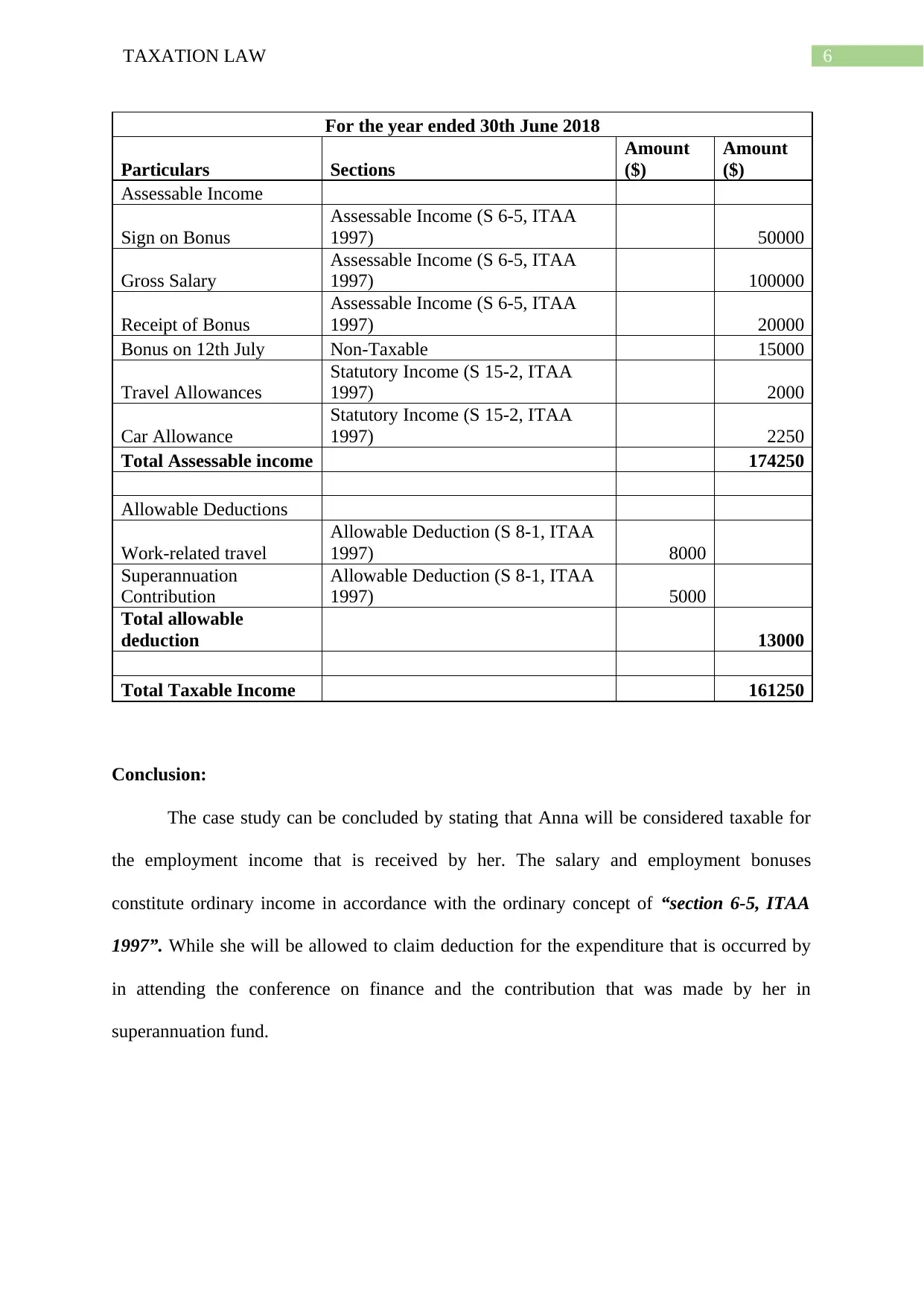
6TAXATION LAW
For the year ended 30th June 2018
Particulars Sections
Amount
($)
Amount
($)
Assessable Income
Sign on Bonus
Assessable Income (S 6-5, ITAA
1997) 50000
Gross Salary
Assessable Income (S 6-5, ITAA
1997) 100000
Receipt of Bonus
Assessable Income (S 6-5, ITAA
1997) 20000
Bonus on 12th July Non-Taxable 15000
Travel Allowances
Statutory Income (S 15-2, ITAA
1997) 2000
Car Allowance
Statutory Income (S 15-2, ITAA
1997) 2250
Total Assessable income 174250
Allowable Deductions
Work-related travel
Allowable Deduction (S 8-1, ITAA
1997) 8000
Superannuation
Contribution
Allowable Deduction (S 8-1, ITAA
1997) 5000
Total allowable
deduction 13000
Total Taxable Income 161250
Conclusion:
The case study can be concluded by stating that Anna will be considered taxable for
the employment income that is received by her. The salary and employment bonuses
constitute ordinary income in accordance with the ordinary concept of “section 6-5, ITAA
1997”. While she will be allowed to claim deduction for the expenditure that is occurred by
in attending the conference on finance and the contribution that was made by her in
superannuation fund.
For the year ended 30th June 2018
Particulars Sections
Amount
($)
Amount
($)
Assessable Income
Sign on Bonus
Assessable Income (S 6-5, ITAA
1997) 50000
Gross Salary
Assessable Income (S 6-5, ITAA
1997) 100000
Receipt of Bonus
Assessable Income (S 6-5, ITAA
1997) 20000
Bonus on 12th July Non-Taxable 15000
Travel Allowances
Statutory Income (S 15-2, ITAA
1997) 2000
Car Allowance
Statutory Income (S 15-2, ITAA
1997) 2250
Total Assessable income 174250
Allowable Deductions
Work-related travel
Allowable Deduction (S 8-1, ITAA
1997) 8000
Superannuation
Contribution
Allowable Deduction (S 8-1, ITAA
1997) 5000
Total allowable
deduction 13000
Total Taxable Income 161250
Conclusion:
The case study can be concluded by stating that Anna will be considered taxable for
the employment income that is received by her. The salary and employment bonuses
constitute ordinary income in accordance with the ordinary concept of “section 6-5, ITAA
1997”. While she will be allowed to claim deduction for the expenditure that is occurred by
in attending the conference on finance and the contribution that was made by her in
superannuation fund.
Paraphrase This Document
Need a fresh take? Get an instant paraphrase of this document with our AI Paraphraser
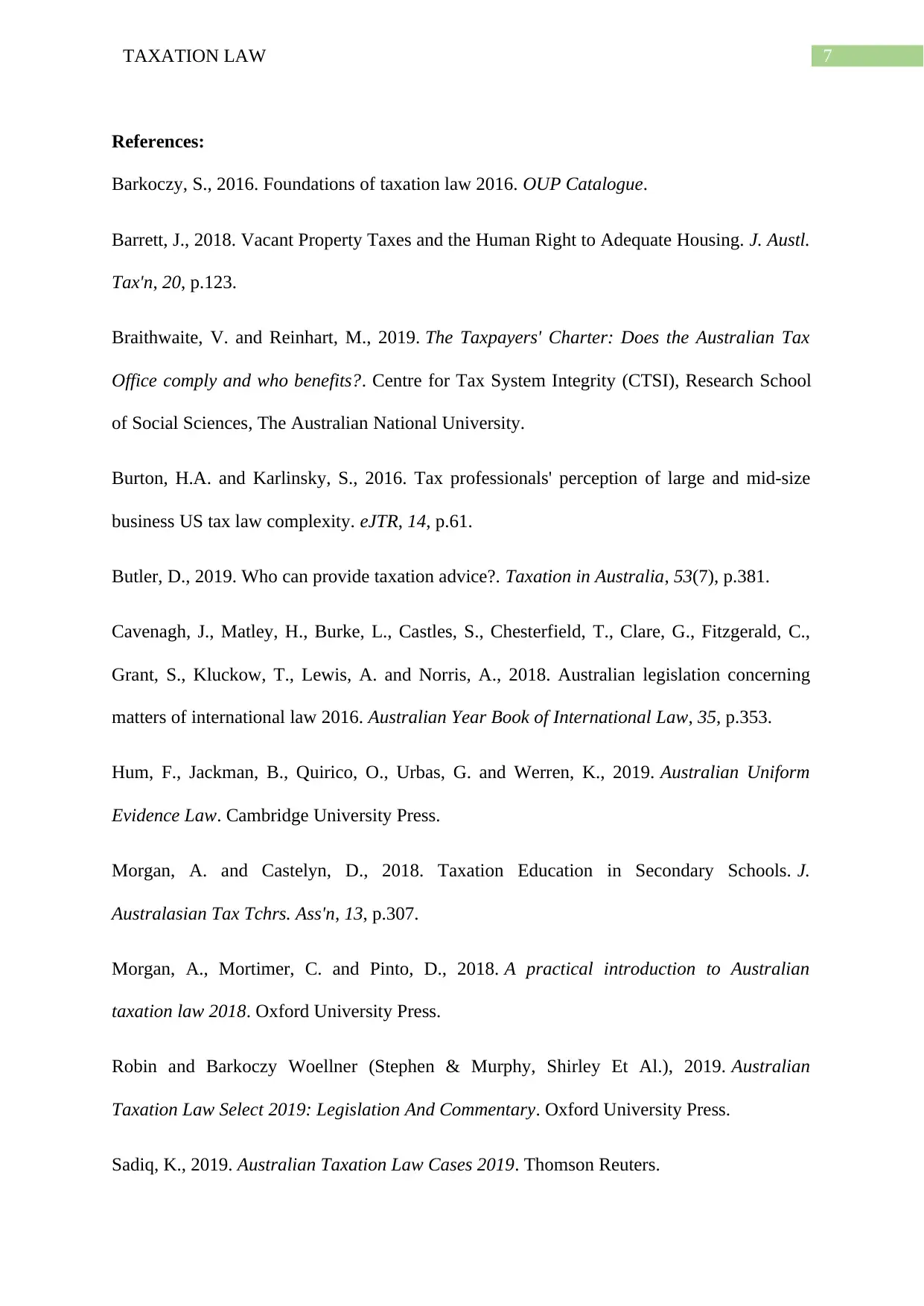
7TAXATION LAW
References:
Barkoczy, S., 2016. Foundations of taxation law 2016. OUP Catalogue.
Barrett, J., 2018. Vacant Property Taxes and the Human Right to Adequate Housing. J. Austl.
Tax'n, 20, p.123.
Braithwaite, V. and Reinhart, M., 2019. The Taxpayers' Charter: Does the Australian Tax
Office comply and who benefits?. Centre for Tax System Integrity (CTSI), Research School
of Social Sciences, The Australian National University.
Burton, H.A. and Karlinsky, S., 2016. Tax professionals' perception of large and mid-size
business US tax law complexity. eJTR, 14, p.61.
Butler, D., 2019. Who can provide taxation advice?. Taxation in Australia, 53(7), p.381.
Cavenagh, J., Matley, H., Burke, L., Castles, S., Chesterfield, T., Clare, G., Fitzgerald, C.,
Grant, S., Kluckow, T., Lewis, A. and Norris, A., 2018. Australian legislation concerning
matters of international law 2016. Australian Year Book of International Law, 35, p.353.
Hum, F., Jackman, B., Quirico, O., Urbas, G. and Werren, K., 2019. Australian Uniform
Evidence Law. Cambridge University Press.
Morgan, A. and Castelyn, D., 2018. Taxation Education in Secondary Schools. J.
Australasian Tax Tchrs. Ass'n, 13, p.307.
Morgan, A., Mortimer, C. and Pinto, D., 2018. A practical introduction to Australian
taxation law 2018. Oxford University Press.
Robin and Barkoczy Woellner (Stephen & Murphy, Shirley Et Al.), 2019. Australian
Taxation Law Select 2019: Legislation And Commentary. Oxford University Press.
Sadiq, K., 2019. Australian Taxation Law Cases 2019. Thomson Reuters.
References:
Barkoczy, S., 2016. Foundations of taxation law 2016. OUP Catalogue.
Barrett, J., 2018. Vacant Property Taxes and the Human Right to Adequate Housing. J. Austl.
Tax'n, 20, p.123.
Braithwaite, V. and Reinhart, M., 2019. The Taxpayers' Charter: Does the Australian Tax
Office comply and who benefits?. Centre for Tax System Integrity (CTSI), Research School
of Social Sciences, The Australian National University.
Burton, H.A. and Karlinsky, S., 2016. Tax professionals' perception of large and mid-size
business US tax law complexity. eJTR, 14, p.61.
Butler, D., 2019. Who can provide taxation advice?. Taxation in Australia, 53(7), p.381.
Cavenagh, J., Matley, H., Burke, L., Castles, S., Chesterfield, T., Clare, G., Fitzgerald, C.,
Grant, S., Kluckow, T., Lewis, A. and Norris, A., 2018. Australian legislation concerning
matters of international law 2016. Australian Year Book of International Law, 35, p.353.
Hum, F., Jackman, B., Quirico, O., Urbas, G. and Werren, K., 2019. Australian Uniform
Evidence Law. Cambridge University Press.
Morgan, A. and Castelyn, D., 2018. Taxation Education in Secondary Schools. J.
Australasian Tax Tchrs. Ass'n, 13, p.307.
Morgan, A., Mortimer, C. and Pinto, D., 2018. A practical introduction to Australian
taxation law 2018. Oxford University Press.
Robin and Barkoczy Woellner (Stephen & Murphy, Shirley Et Al.), 2019. Australian
Taxation Law Select 2019: Legislation And Commentary. Oxford University Press.
Sadiq, K., 2019. Australian Taxation Law Cases 2019. Thomson Reuters.
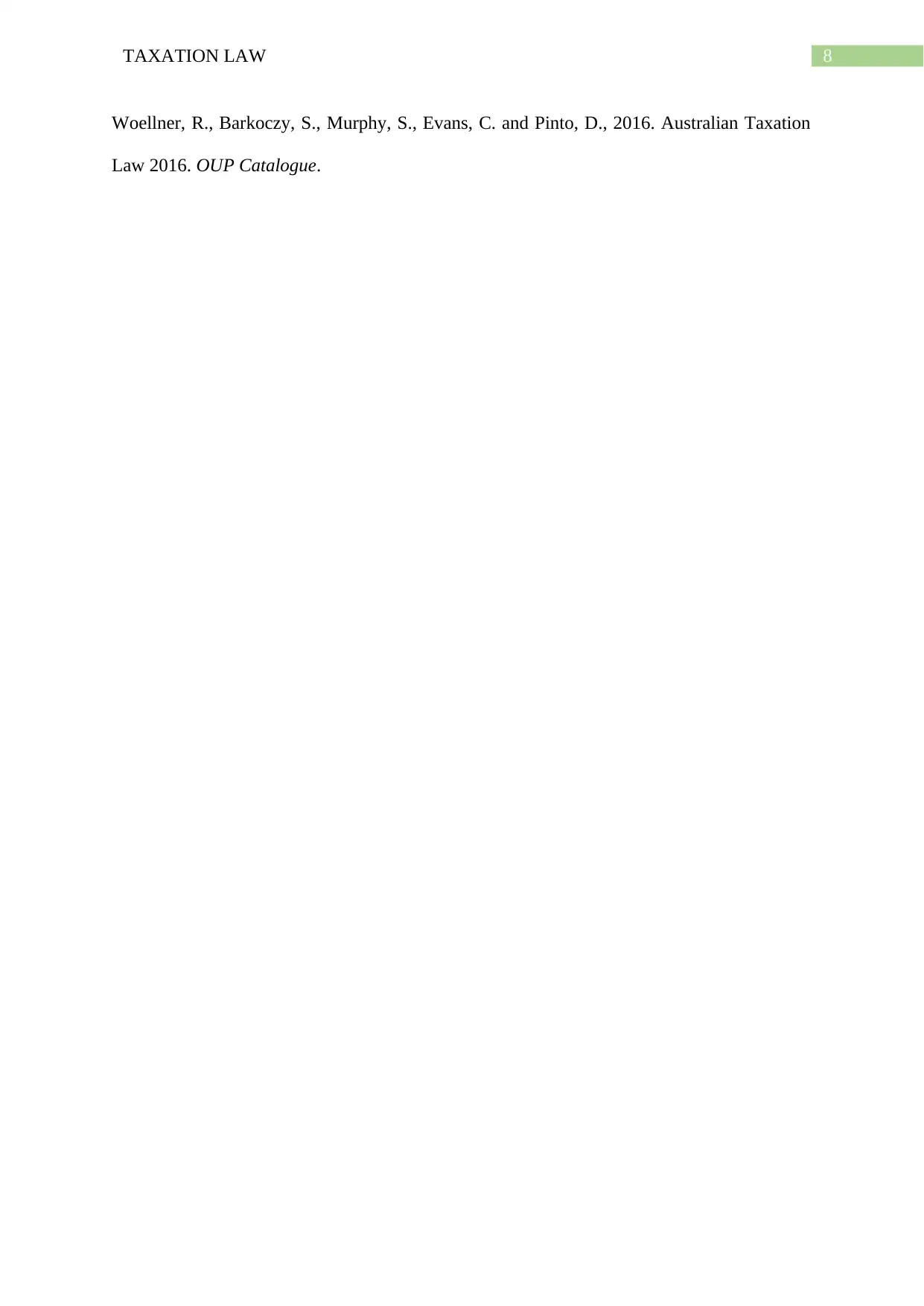
8TAXATION LAW
Woellner, R., Barkoczy, S., Murphy, S., Evans, C. and Pinto, D., 2016. Australian Taxation
Law 2016. OUP Catalogue.
Woellner, R., Barkoczy, S., Murphy, S., Evans, C. and Pinto, D., 2016. Australian Taxation
Law 2016. OUP Catalogue.
1 out of 9
Related Documents
Your All-in-One AI-Powered Toolkit for Academic Success.
+13062052269
info@desklib.com
Available 24*7 on WhatsApp / Email
![[object Object]](/_next/static/media/star-bottom.7253800d.svg)
Unlock your academic potential
© 2024 | Zucol Services PVT LTD | All rights reserved.





